top of page

SENIOR WELLNESS
This project entailed designing a solution to enhance the wellness of seniors living in senior homes. We focused on the mental wellness component and developed a solution to help seniors build meaningful connections in the home through shared creative experiences.
My Role
MY ROLE
With positive energy and enthusiasm, I coordinated the team’s working structure to maximize the quality of our output. This entailed strategically planning and structuring the agenda for meetings, effectively managing communication within the team and efficiently distributing the workload to ensure equal contribution from all members.
EXPLORING SCOPE OF CHALLENGE
Using Political, Economic, Social, Technological, Legal and Environmental (PESTLE) trends as navigation aids, I conducted research to understand their direct impact on our project while also developing a greater context of the problem statement.
CONDUCTING USER RESEARCH
We visited a senior care facility to observe and directly interact with seniors, caregivers and the administrative staff. I also met and interacted with seniors in more informal settings such as at libraries and cafes. My goal was to leverage natural interactions to build a deeper sense of empathy.
DEFINING PRODUCT REQUIREMENTS
Given the importance of mental wellbeing, I championed the need for a solution that would stimulate rich mental activity. I was successfully able to induce the notion of building a ecosystem that would engage the various stakeholders.
CREATING CONCEPT PROTOTYPE
In detailing the platform architecture, I designed various components of the solution i.e. the system and the informational content to support the software. With an eagerness to expand my skill set, I designed the visual content for the client presentation and report.

Problem Statement
THE CHALLENGE
ENHANCE SENIOR WELLNESS
The elderly have long been neglected demographic when it comes to their wellbeing. There are a plethora of products and services aimed at a younger and more tech-savvy audience as opposed to the fewer options for seniors. This is a jarring contrast given the convergence of an aging society with ubiquitous availability of advanced technology today.
Our goal with this project was to leverage the opportunity to innovate within the space of senior care facilities to improve the lives of seniors residing there.
The guiding principles were:
-
The solution can be a product and/or service
-
The solution can be focused on short and/or long term senior care
-
The solution can not focus on Alzheimer’s or memory care-units

Solution Approach
THE APPROACH
At seven weeks, time management was of the utmost importance with this project. It was thus imperative that a working structure be established and observed in order for us to have the maximum impact in developing a solution for this challenge. We decided to utilize a stage-gate process allowing for iterations within stages.
DOUBLE DIAMOND
This project was conducted in accordance with the ‘Double Diamond’ principle. For this, the project is broken down into two broad phases: designing the right thing and designing things right.
In the first diamond, detailed research is conducted to explore the problem space. By identifying pertinent factors and their effects, an intimate understanding is developed. The first phase sees its culmination with the selection of a final solution brief i.e. the identification of product requirements.
In the second diamond, numerous concept approaches are generated, investigated and analyzed for their strengths and weaknesses till a final solution is selected, detailed and refined.
Both phases see a period of divergence wherein diversity of thoughts are entertained. During the divergence portions, all ideas from mild to wild are considered and evaluated. The period of convergence sees ideas grouped into categories to facilitate the down selection of problem statements and final solution approaches.
PESTLE FACTORS
By structuring the problem space exploration under the genres of Political, Economic, Social, Technological, Legal and Environmental topics, we were able to consider a wide range of factors that might have an influence on our project. This was instrumental in guiding our user research as it provided much needed context for such a broad topic.
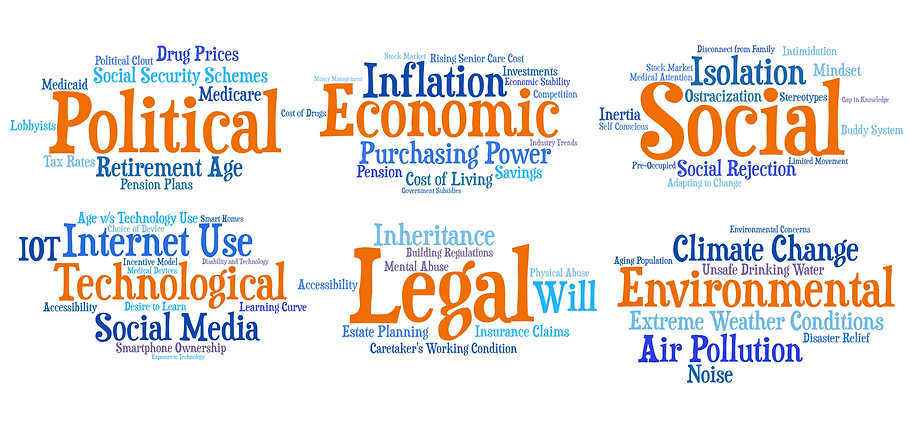
USER RESEARCH
Our user research was predated by an identification of the stakeholders that might be concerned with / influenced by our project. Recognition of stakeholders proved instrumental in our visit to the Weinberg Terrace senior home. It helped us construct our questionnaire for maximum relevance and impact with the concerned parties.
KEY FACTORS
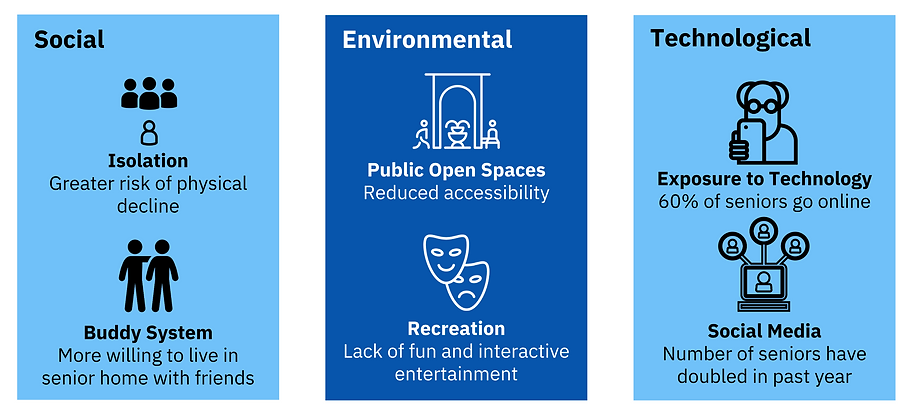
User Research


KEY INSIGHTS
Following our visit to the senior home, we collated our observations and then as a group identified some key insights that would then inform our opportunity identification process.

Personas
PERSONAS
In order for us to build empathy towards the target demographic, we constructed two personas. These personas form the foundation for our solution development by serving as a communication tool to test ideas. The personas enables us to ask questions like, “Do you think Anna’s going to enjoy that experience?” or “How does this help Janice?”
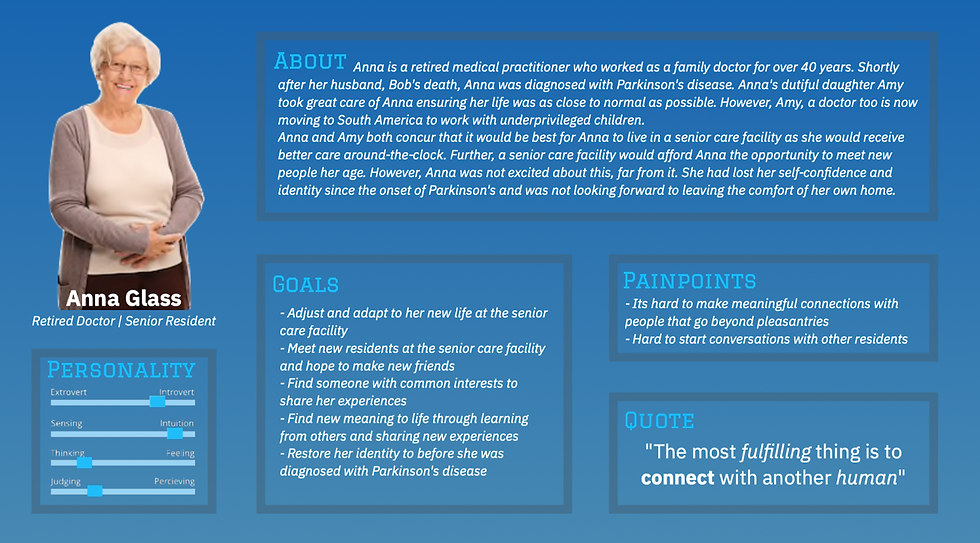

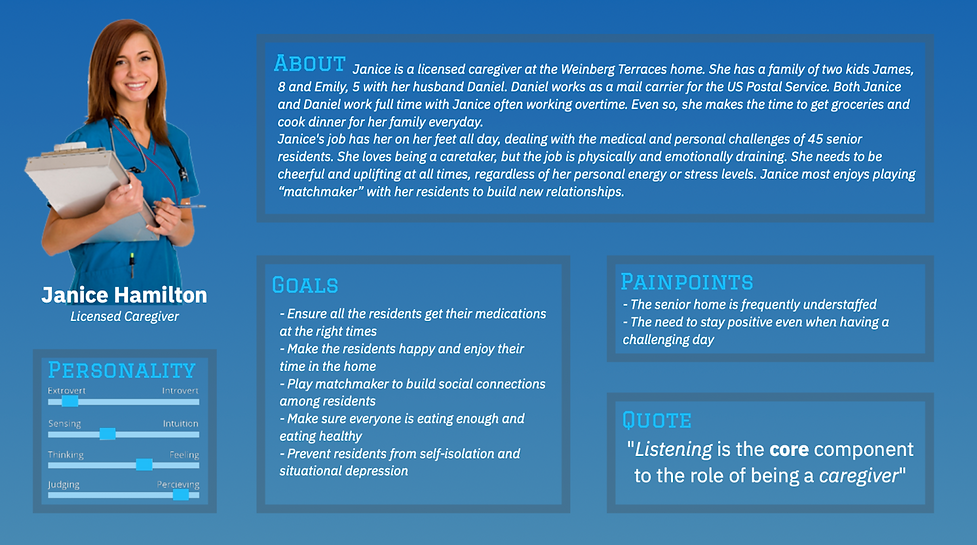
POTENTIAL SOLUTION OPPORTUNITIES
Starting with the key PESTLE factors and using our insights as guidelines, we identified almost 50 potential problems with opportunities for us to build a solution.
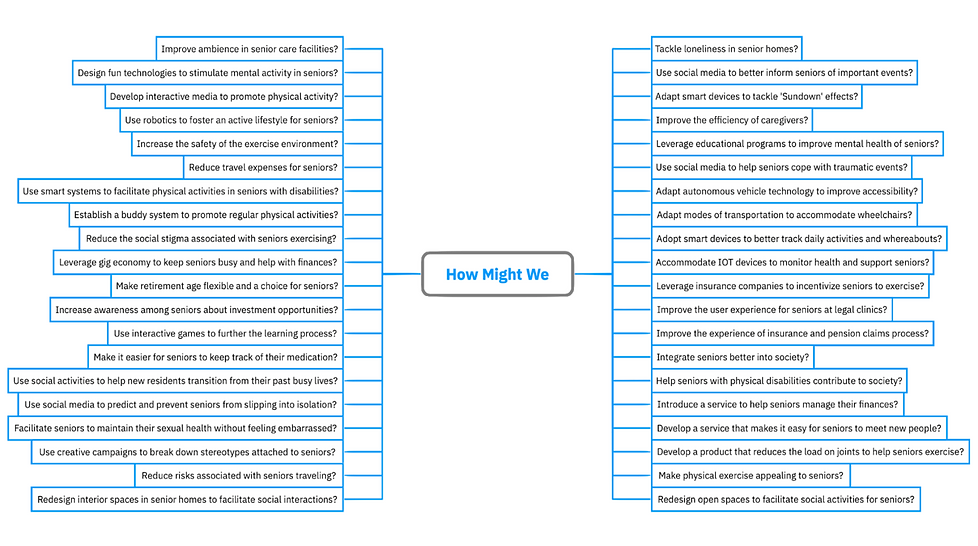
Product Opportunities
PRODUCT OPPORTUNITY GAPS
Now, 50 potential problems or Product Opportunity Gaps (P.O.G.s) to solve might sound exciting but we very quickly realized that a number of these P.O.G.s are complementary. In view of this realization, we combined our 50 P.O.G.s into 14 Super P.O.G.s i.e. new and more inclusive product opportunity gaps.

SELECTION PROCESS
To enable a fair and efficient method of convergence to a final problem statement, we selected a set of criteria to evaluate these 14 Super P.O.G.s. Weights were assigned to allow varying levels of influence by the criteria in the scoring process.
Each team member rated the Super P.O.G.s on a scale of 1-5 for each criteria. All the individual scores were then aggregated in a matrix that took the average value of our respective criteria ratings to then construct a final reduction matrix.

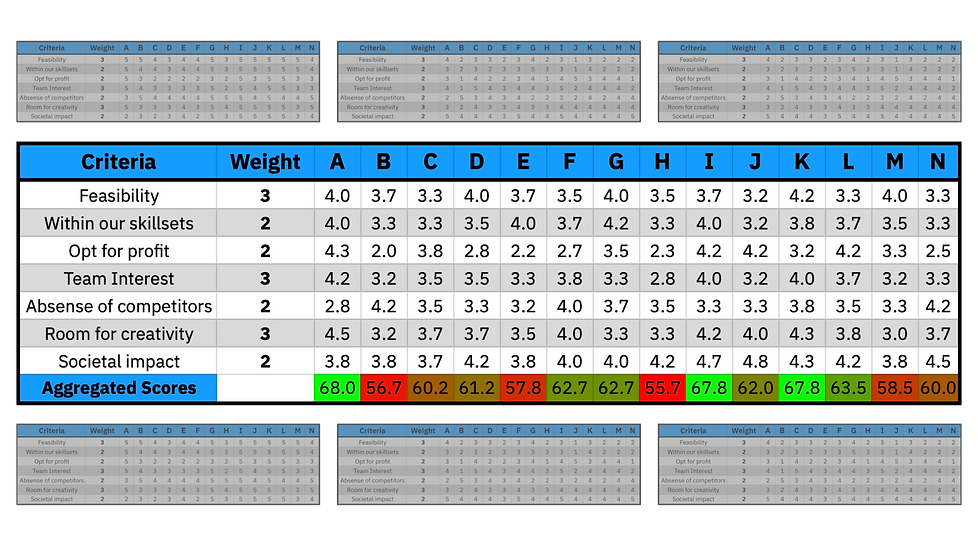
As we had three top contenders, a quick team discussion helped selected our final product opportunity.

“Digitizing the legacy of seniors to enhance connections with family and the community”
Opportunity Validation
OPPORTUNITY VALIDATION
Having identified an opportunity to pursue, it was imperative that we revisit the senior care facility to get feedback on our approach. I believe that it is absolutely essential to validate an idea with the core user group before proceeding to develop a solution. User feedback when used in a stage-gate format helps to maximize efficiency of the solution development process.
Research Questions:
-
Have you thought about leaving your legacy?
-
What might that look like to you?
-
What does sharing stories about your life mean to you?
-
Who would you like to share your stories with?
-
What do you feel about sharing your story with a device?
-
Would you be interested in learning about the stories of other seniors?
LESSONS LEARNT
The responses we received surprised us. One senior, who had lived in the home for over 5 years, spoke about how much he enjoyed living there and did not miss his family all that much. He had a number of friends in the home and vibrant social life from what we observed. However, he mentioned that the transition phase from his home to the senior care facility was a challenge. This emotion was echoed by a number of other seniors.
It was at this moment that I realized that we had the right approach but were looking at the wrong opportunity. Hearing it from the seniors, I realized that it was more important for seniors to move on and live their lives by making new social connections rather than staying in a dependant relationship with their families. As a grandchild, this was a bitter pill to swallow but it reaffirms the need to detach oneself from the opportunity while giving sole importance to the voice of the user. Further, the legacy portion was plagued with the problem of latency that would be created for a social interaction, if any, to occur between two seniors.
It was this realization that prompted us to reframe the problem by crafting a scenario that would help us focus on the real problem.

User Jouney Map
Thus our refined problem statement became:

“Digitize storytelling to foster meaningful connections between residents in a senior care facility”
Product Requirements
DEFINING PRODUCTS REQUIREMENTS
Having fine-tuned our problem statement, we proceeded to envision a solution. It was at this stage that we realized a need for the definition of product requirements. We defined a series of factors that were used to compare the status quo with our proposed solution. Identifying opportunities or large gaps in values of these factors help build the product requirements. These product requirements are crucial as they facilitate the ideation stage by providing for a set of guidelines to experiment within.
“Product Requirements form the board for the ideation games to be played on”
Status Quo: Caregivers connect with and get to know the new senior residents. Then they introduce these new residents to other residents in the home based on experiences and interests that they both might have in common. This system is clunky and cumbersome and relies heavily on the performance of the caregiver putting tremendous pressure on the caregivers.


Ideation
BRAINSTORMING
As a team, we employed the Crazy 8s activity to conduct a series of ideation sprints. Having generated a numerous ideas, we affinity mapped these ideas. We then conducted a dot voting exercise to select and prototype our top 2 concepts.
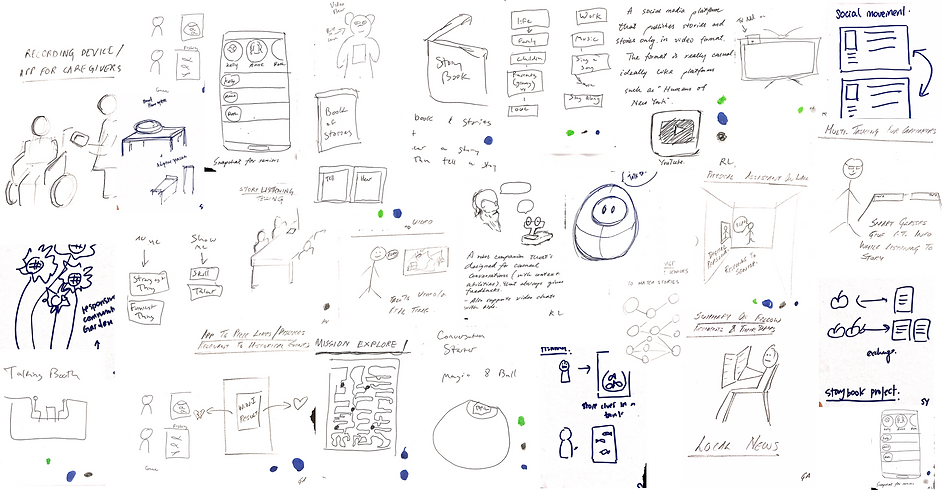

KEY CONCEPT ONE
KEY CONCEPT TWO

Concepts
Recognizing that these two concepts have complementary strengths that can help overcome their individual weaknesses, we decided to combine the two concepts to build our final solution titled, “Social Stories”.
Social Stories utilizes the profile matching aspect of the physical social network but disregards a robot companion in the favor of the omnipresent smartphones. Once seniors are matched based on the similarity of their interests, the prompt cards serve as a conversation starter to enable a shared creative challenge for the seniors. This shared activity decreases the stress of conversing with a stranger allowing for meaningful connections to blossom.
Accessibility is provided with the implementation of Natural Language Processing. Seniors can then input, share and consume stories in text or audio format.
SOCIAL STORIES: STORYBOARD
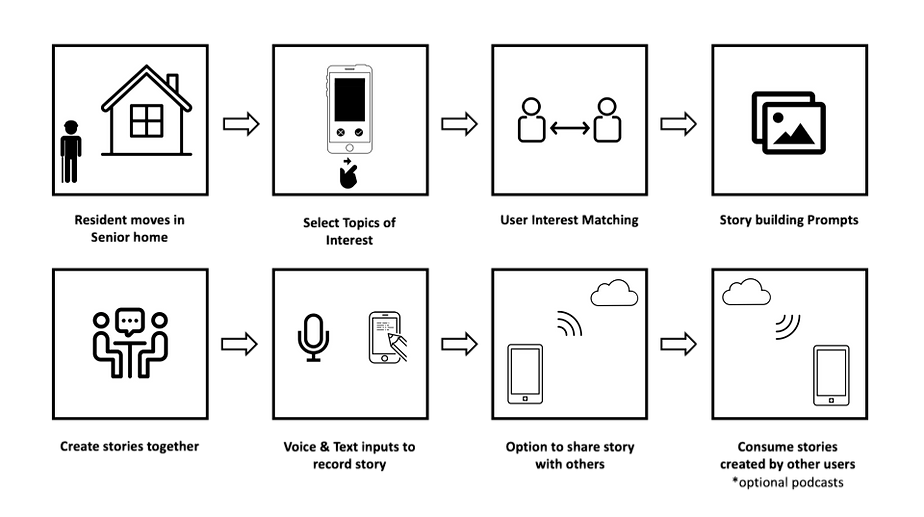

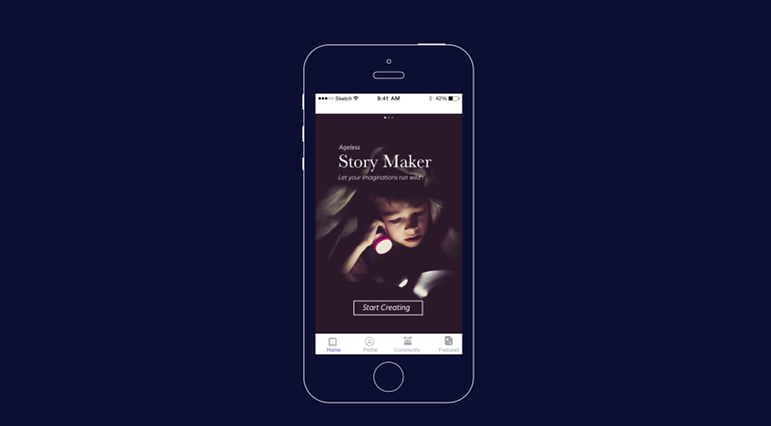
Credit: Sisi Yu
WIREFRAME
Credit: Sisi Yu
Usability Testing
USABILITY TESTING
Having developed Social Stories, we decided to build some low fidelity prototypes and conduct usability tests at the senior home with our users. While the seniors enjoyed the overall experience that Social Stories afforded to them, they were a little uncomfortable with the solution being all digital. We noticed this as it took time and effort to explain the app’s interface to them.
We realized then, the need to reinterpret Social Stories by adding tangible physical components. Thus, Social Stories comes into editions, a physical and a digital. The physical edition is designed for the less tech savvy seniors while the digital edition is designed for the seniors of the future.
SOCIAL STORIES: PHYSICAL EDITION
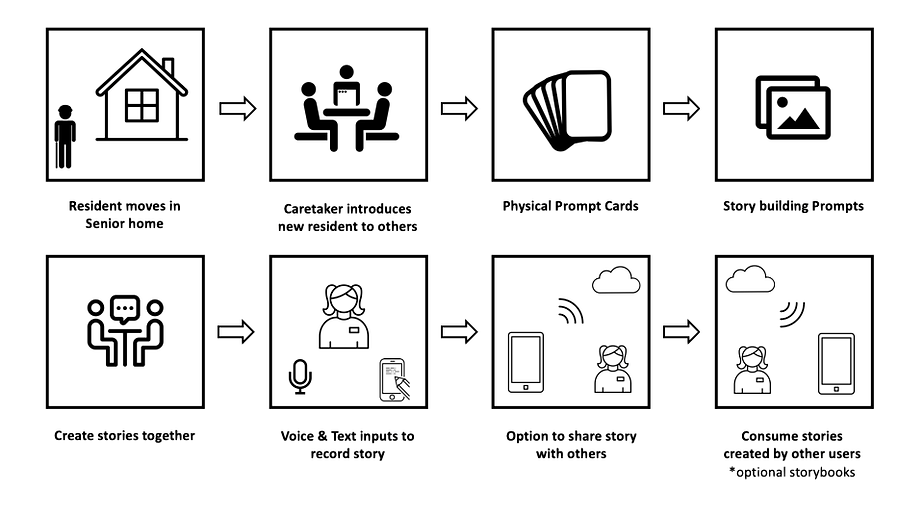
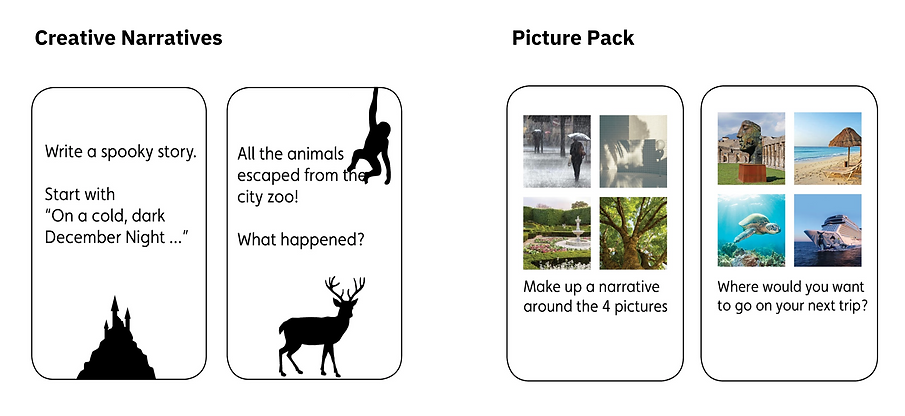
USER JOURNEY MAP: FORECASTED
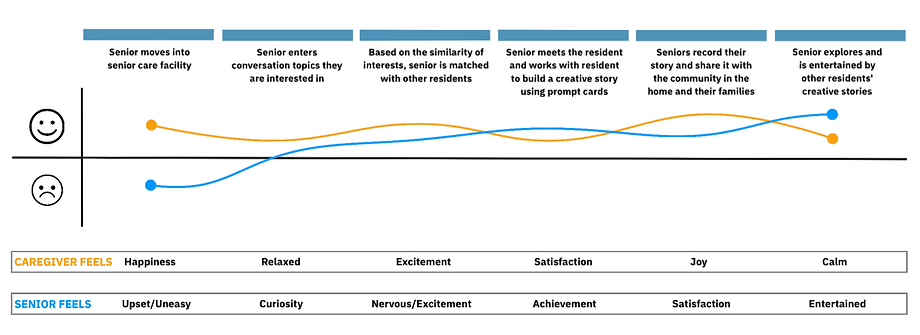

Building meaningful connections through a shared creative experience
My Learning
WHAT DID I LEARN ?
This project opened my eyes to the world of product opportunities available to improve the wellbeing of seniors. With life expectancy rising the space is ripe for the creation of new and innovative products and services.
In analyzing the problem space, I learnt to not make assumptions and instead pay attention solely to the voice of the user. As a team, we learnt that it did not matter whose idea finally ended up being the solution. The only thing that mattered was how it improved the lives of the users. This project showed me the importance of working with users to develop a solution as opposed to merely presenting them with one. This was instrumental in Social Stories having digital and physical editions.
Additionally, working in an interdisciplinary team of engineers, designers and business students, allowed me to hone in on my management skills. I learnt how to play a unifying role in a team of strong personalities.
bottom of page
